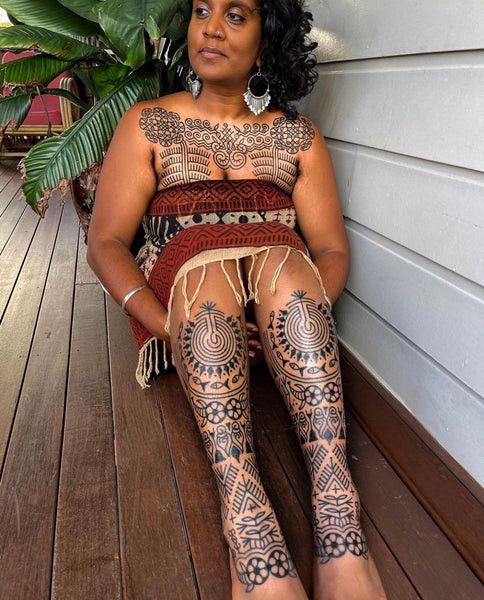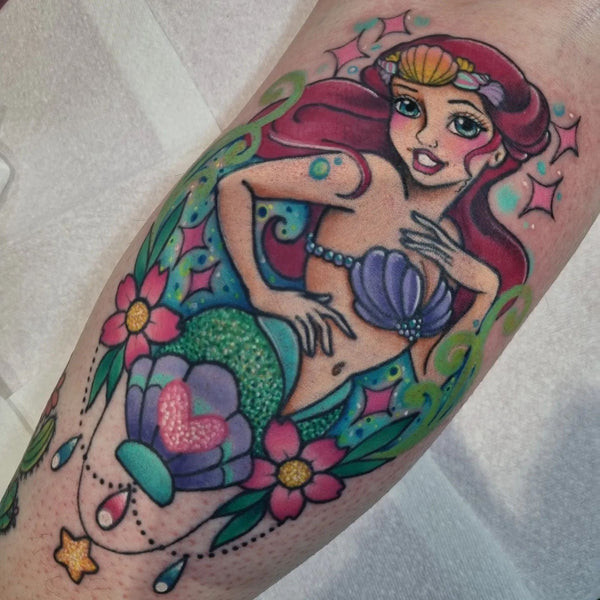Do Calf Tattoos Take Longer To Heal compared to other areas of the body? Yes, calf tattoos can sometimes take a bit longer to heal due to factors like circulation, skin tightness, and constant movement. At tattooat.com, we provide essential information and guidance on tattoos and body art to ensure proper aftercare and a smooth healing process. By understanding these factors and following expert aftercare tips, you can promote optimal healing and keep your new calf tattoo looking vibrant.
1. Understanding the Healing Process of Calf Tattoos
1.1. Why Might Calf Tattoos Take Longer to Heal?
Several factors can influence the healing time of calf tattoos.
- Blood Circulation: The lower leg, including the calf, might have slightly poorer blood circulation compared to areas closer to the heart. This can slow down the delivery of nutrients and immune cells needed for healing.
- Skin Tightness: The skin on the calf is often tighter and more stretched, especially for those who are active. This can create more stress on the tattoo during the healing process.
- Constant Movement: The calf is a highly mobile area, used extensively for walking, running, and other leg movements. This constant motion can irritate the new tattoo, potentially prolonging the healing time.
- Clothing Friction: Trousers, socks, and shoes can rub against the new tattoo, causing irritation and increasing the risk of infection.
1.2. The Typical Tattoo Healing Timeline
Generally, a tattoo goes through several stages of healing:
- Week 1: The tattoo is fresh, tender, and may ooze some ink and plasma.
- Week 2: The tattoo starts to scab. It’s crucial not to pick at the scabs to avoid damaging the ink.
- Week 3: The scabs begin to fall off, and the tattoo might look milky or cloudy.
- Week 4: The outer layer of skin has healed, but the deeper layers are still regenerating.
- Months 2-6: The skin continues to heal and settle, with the colors becoming more vibrant.
While this is a general timeline, individual healing experiences can vary. A calf tattoo might linger in the scabbed or milky stage slightly longer due to the factors mentioned above.
1.3. Factors Affecting Tattoo Healing Speed
Several factors can influence how quickly or slowly a tattoo heals:
| Factor | Description |
|---|---|
| Individual Health | A person’s overall health, immune system strength, and any underlying medical conditions can affect healing speed. |
| Age | Younger individuals tend to heal faster than older adults due to more efficient cell regeneration. |
| Lifestyle | Habits like smoking, excessive alcohol consumption, and poor diet can slow down the healing process. |
| Aftercare Routine | Following the tattoo artist’s aftercare instructions meticulously is crucial. Proper cleaning, moisturizing, and protection from the sun can significantly impact healing. |
| Tattoo Size & Design | Larger and more intricate tattoos naturally take longer to heal than smaller, simpler ones. The amount of trauma to the skin is greater with extensive tattooing. |
| Tattoo Location | Areas with higher friction or movement, like the calf, may experience prolonged healing times compared to less-used areas. |
| Ink Quality | The quality of the tattoo ink can also play a role. High-quality inks are less likely to cause allergic reactions or complications that could impede healing. |
| Artist Skill | A skilled tattoo artist will apply the ink properly, minimizing trauma to the skin. This can lead to faster healing and better overall results. |
2. Expert Insights on Calf Tattoo Healing
2.1. Advice from Tattoo Artists
Tattoo artists often share valuable insights based on their experience. Many emphasize the importance of diligent aftercare.
- Pixie Robson (@pixierobsontattoo): “Healing is more to do with the person than the area. Always follow the aftercare advice given to you by the artist who’s done the tattoo.”
- Swasthik Iyengar: Highlights the importance of choosing the right artist and following their specific aftercare instructions to ensure the tattoo heals properly.
2.2. Recommended Aftercare Practices
Proper aftercare is essential for ensuring your calf tattoo heals well. Here are some guidelines:
- Keep it Clean: Gently wash the tattoo with mild, fragrance-free soap and warm water 2-3 times a day.
- Moisturize: Apply a thin layer of tattoo-specific moisturizer or a fragrance-free lotion to keep the skin hydrated. Avoid over-moisturizing, as this can trap bacteria.
- Avoid Sun Exposure: Keep the tattoo out of direct sunlight. UV rays can damage the ink and slow down healing.
- Wear Loose Clothing: Opt for loose-fitting clothing to minimize friction and allow the tattoo to breathe.
- Stay Hydrated: Drinking plenty of water helps keep your skin hydrated from the inside out.
- Avoid Soaking: Refrain from swimming, baths, and saunas until the tattoo is fully healed.
- Don’t Pick or Scratch: Resist the urge to pick at scabs or scratch the tattoo, as this can lead to scarring and ink loss.
2.3. Products That Aid Healing
Certain products can assist in the tattoo healing process:
- Tattoo Aftercare Creams: Products like Stories & Ink Aftercare Cream are designed to keep your tattoo moisturized without clogging pores.
- Fragrance-Free Soaps: Mild, fragrance-free soaps are gentle on the skin and won’t cause irritation.
- Sunscreen: Once the tattoo is fully healed, use a high-SPF sunscreen to protect it from UV damage.
3. Addressing Common Concerns and Complications
3.1. Recognizing Signs of Infection
It’s crucial to monitor your tattoo for signs of infection. Common symptoms include:
- Excessive redness or swelling
- Increased pain or tenderness
- Pus or oozing
- Fever
- Swollen lymph nodes
If you experience any of these symptoms, seek medical attention immediately.
3.2. Dealing with Itching and Irritation
Itching is a normal part of the healing process, but excessive scratching can damage the tattoo. Here are some tips to relieve itching:
- Apply a cold compress
- Gently pat the tattoo instead of scratching
- Use a tattoo-specific balm or lotion
3.3. Preventing Fading and Blowouts
Proper aftercare can help prevent fading and blowouts (when the ink spreads beyond the intended lines). Key strategies include:
- Protecting the tattoo from sun exposure
- Avoiding excessive stretching or movement
- Keeping the skin properly hydrated
 Leg tattoos
Leg tattoos
4. Optimizing Your Calf Tattoo Experience
4.1. Choosing the Right Design
Selecting the right design can enhance your overall experience. Consider the shape and contours of your calf when choosing a design. Popular options include:
- Mandala Tattoos: Ornamental tattoos that can cover shins and knees.
- Flower Tattoos: Classic roses, peonies, or bouquets.
- Animal Tattoos: Lions, dragons, butterflies, or snakes that complement the leg’s shape.
- Japanese Tattoos: Koi carp, dragons, and traditional motifs.
- Tribal Tattoos: Patterns and geometrical shapes for a unique look.
4.2. Finding a Skilled Tattoo Artist
Researching and choosing a skilled tattoo artist is crucial. Look for an artist with experience in the style you want and a reputation for cleanliness and professionalism. Check out their portfolio and read reviews to ensure they’re the right fit for you.
4.3. Preparing for Your Tattoo Appointment
Proper preparation can make your tattoo appointment more comfortable and help ensure a smooth process. Follow these tips:
- Stay Hydrated: Drink plenty of water in the days leading up to your appointment.
- Moisturize: Keep your skin well-moisturized.
- Avoid Alcohol and Blood Thinners: Refrain from alcohol and blood-thinning medications before your appointment.
- Wear Comfortable Clothing: Choose loose-fitting clothing that won’t irritate the area.
- Eat a Good Meal: Have a substantial meal before your appointment to keep your blood sugar stable.
5. Real-World Examples and Case Studies
5.1. Case Study: Slower Healing Due to Activity
Scenario: A 28-year-old runner gets a calf tattoo and continues their running routine shortly after.
Outcome: The tattoo takes longer to heal due to increased sweating, friction, and skin movement. The runner experiences irritation and prolonged scabbing.
Lesson: It’s important to avoid strenuous activities until the tattoo is at least in the “dry and itchy” stage of healing.
5.2. Case Study: Successful Healing with Proper Aftercare
Scenario: A 35-year-old individual gets a calf tattoo and meticulously follows their artist’s aftercare instructions.
Outcome: The tattoo heals within the expected timeframe, with minimal scabbing and no signs of infection.
Lesson: Diligent aftercare is crucial for a successful healing process.
5.3. Expert Tip from tattooat.com
“At tattooat.com, we’ve seen countless calf tattoos heal beautifully when clients prioritize hydration, cleanliness, and protection. Remember, your body art is an investment, and proper care ensures it looks stunning for years to come.”
6. Tattoo Styles and Their Impact on Healing
6.1. Linework vs. Shading
- Linework Tattoos: These often heal faster because they involve less trauma to the skin compared to tattoos with extensive shading.
- Shading Tattoos: Shading requires more passes over the skin, which can lead to increased inflammation and longer healing times.
6.2. Color vs. Black and Grey
- Black and Grey Tattoos: Generally, these heal slightly faster because black ink is less likely to cause allergic reactions than colored inks.
- Color Tattoos: Colored inks can sometimes cause allergic reactions or sensitivities, potentially prolonging the healing process. Red ink is a common culprit for allergic reactions.
6.3. Bold vs. Fine-Line
- Bold Tattoos: Bold designs with thicker lines tend to be more resilient during the healing process because the ink is more concentrated.
- Fine-Line Tattoos: Fine-line tattoos require precise application, and any disruption during healing can affect the crispness of the lines.
7. Lifestyle Adjustments During Healing
7.1. Clothing Choices
Opt for loose, breathable fabrics like cotton. Avoid tight clothing that can rub against the tattoo and cause irritation.
7.2. Sleeping Positions
Try to avoid sleeping directly on your calf tattoo, as this can restrict airflow and increase pressure. If possible, sleep on your back or side with the tattooed leg elevated.
7.3. Avoiding Sun and Water
Sun exposure can cause fading and damage to the tattoo. Keep it covered with clothing or use a high-SPF sunscreen. Avoid swimming, hot tubs, and prolonged soaking, as water can harbor bacteria and interfere with healing.
8. The Psychological Aspect of Tattoo Healing
8.1. Managing Expectations
It’s important to have realistic expectations about the healing process. Understand that it takes time and patience, and there may be ups and downs along the way.
8.2. Staying Positive
Focus on the positive aspects of your new tattoo. Remind yourself of the reasons why you got it and visualize the final result.
8.3. Seeking Support
If you’re feeling anxious or overwhelmed, reach out to your tattoo artist, friends, or online communities for support. Sharing your experiences and concerns can help you stay motivated and informed.
9. Advanced Aftercare Techniques
9.1. Second-Skin Bandages
Second-skin bandages, like Saniderm or Tegaderm, can protect the tattoo and promote faster healing. These bandages are breathable and waterproof, allowing the skin to heal in a moist environment.
9.2. Cold Laser Therapy
Some tattoo studios offer cold laser therapy to reduce inflammation and promote healing. This non-invasive treatment can help speed up the recovery process and minimize discomfort.
9.3. Nutritional Support
Eating a healthy diet rich in vitamins, minerals, and antioxidants can support your body’s healing abilities. Focus on foods that promote skin health, such as fruits, vegetables, lean proteins, and healthy fats.
10. The Future of Tattoo Aftercare
10.1. Innovations in Tattoo Inks
Researchers are constantly developing new tattoo inks that are safer, more vibrant, and less prone to fading. These advancements could lead to improved healing outcomes and long-lasting results.
10.2. Personalized Aftercare Plans
In the future, tattoo artists may offer personalized aftercare plans based on individual skin types, lifestyles, and tattoo designs. These tailored recommendations could further optimize the healing process and minimize complications.
10.3. Telemedicine for Tattoo Aftercare
Telemedicine platforms could provide remote consultations with tattoo artists or healthcare professionals, allowing individuals to receive guidance and support from the comfort of their own homes. This could be especially beneficial for those who live in rural areas or have limited access to tattoo aftercare resources.
Navigating the world of tattoos involves more than just choosing the perfect design; understanding the healing process and providing proper aftercare are essential for ensuring your body art remains vibrant and healthy. Whether you’re considering your first tattoo or adding to your collection, remember that patience, diligence, and expert guidance are your best allies.
 Ariel leg tattoo
Ariel leg tattoo
At tattooat.com, we’re dedicated to providing you with the resources and support you need to make informed decisions about your body art journey. From design inspiration to aftercare tips, our goal is to empower you to express yourself confidently and safely.
Ready to explore more designs, find talented artists, and dive deeper into the world of tattoos? Visit tattooat.com today and discover a wealth of information to guide your journey.
Address: 1825 SW Broadway, Portland, OR 97201, United States
Phone: +1 (503) 725-3000
Website: tattooat.com
FAQ: Calf Tattoo Healing
1. Why does my calf tattoo itch so much?
Itching is a normal part of the healing process. As the skin regenerates, it can cause an itchy sensation. Avoid scratching and use a tattoo-specific balm or lotion to relieve the itch.
2. How long should I wait before exercising after getting a calf tattoo?
Wait until your tattoo is at least in the “dry and itchy” stage of healing before resuming strenuous activities. This usually takes about 2-3 weeks.
3. Can I wear leggings after getting a calf tattoo?
Avoid wearing tight leggings until the tattoo is fully healed. Opt for loose-fitting clothing to minimize friction and allow the tattoo to breathe.
4. What should I do if my calf tattoo gets infected?
If you suspect your tattoo is infected, seek medical attention immediately. Symptoms of infection include excessive redness, swelling, pain, pus, and fever.
5. How often should I moisturize my calf tattoo?
Moisturize your tattoo 2-3 times a day, or as needed to keep the skin hydrated. Avoid over-moisturizing, as this can trap bacteria.
6. Can I use petroleum jelly on my calf tattoo?
Petroleum jelly is not recommended for tattoo aftercare, as it can clog pores and trap bacteria. Opt for tattoo-specific moisturizers or fragrance-free lotions.
7. How long does it take for a calf tattoo to fully heal?
A calf tattoo typically takes 2-4 weeks to heal, but individual healing times can vary.
8. Can I shave my legs after getting a calf tattoo?
Avoid shaving your legs until the tattoo is fully healed. Shaving can irritate the skin and increase the risk of infection.
9. What are the best aftercare products for calf tattoos?
Look for tattoo-specific aftercare creams, fragrance-free soaps, and high-SPF sunscreens. Products like Stories & Ink Aftercare Cream are designed to keep your tattoo moisturized without clogging pores.
10. How can I protect my calf tattoo from the sun?
Keep your tattoo covered with clothing or use a high-SPF sunscreen. Sun exposure can cause fading and damage to the ink.
